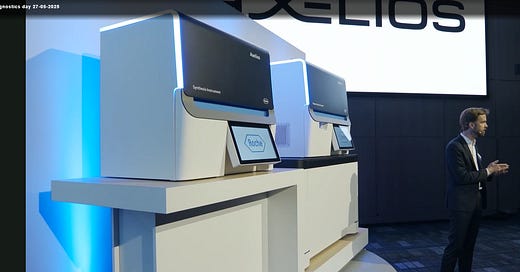Will Illumina lengthen their read lengths to protect against Roche SBX?
It only makes sense by acknowledging the value of long reads
A few months ago, we got a taster of the Roche SBX sequencing technology, product of the acquisition and integration of Genia an Stratos about a decade ago.
In a recent webinar, Roche showed updated results of this platform, which will become available in 2026, with two differentiated modes: SBX-Duplex for shorter reads of High Accuracy, and SBX-Simplex, for higher throughput longer reads of a lower quality in comparison.
Roche presented what they think is a market for this longish SBX-Simplex reads, including single cell transcriptomics and PerturbSeq applications. The modal read length distribution is around 600bp, with about 5% of the reads above 1000bp.
Will 600bp reads change Illumina’s strategy?
Illumina has shown that they are capable of 600 cycle SBS runs for a long time: first with their original MiSeq 2x300bp kit, later on with iterations of the same technology in small NovaSeq flowcells and now both MiSeq i100 and NextSeq configurations (and NovaSeq 6000 2x250bp runs).
But the company’s main product is still the 2x150bp sequencing run, which is half the length of 2x300bp, and about half the run time, depending on the instrument and flow cell configuration.
So up until now, Illumina has been telling their customers: “2x150bp should be your de facto standard, but you can do 2x300bp if you are willing to pay more per base pair and afford the longer run times”.
The highest throughput 2x300bp Illumina run produces data at about 8-10x the expense of the same base pair equivalent in 2x150bp NovaSeq X Plus runs.
(full table available at http:/bit.ly/ngsspecs)
Illumina also announced months ago that they’ll be selling a 2x500bp MiSeq i100 kit sometime in 2026, which will make the instrument a necessity for customers needing longer than 600 cycle datasets if they only have the NextSeq instrument available.
In the absence of Roche SBX’s threat, this all makes sense commercially for Illumina: the highest throughput instrument, NovaSeq X, shouldn’t be used for “niche” applications, but rather in producing the maximum throughput for more common applications like population genomics, cancer diagnostics, etc. Then the smaller NextSeq instruments should afford more flexibility, with 2x300bp kits available for those who need it. Finally, those customers needing 2x500bp reads will have to pony up and pay for a MiSeq i100, so this encourages sales and helps in segmenting the market for Illumina.
The problem is that the Roche SBX instrument, as it has been defined publicly so far, threatens all 3 instrument lines in Illumina’s portfolio: it is as high throughput as the NovaSeq X, but even faster at generating data, it can deal with mid-sized runs like the NextSeq, and with the SBX-simplex read length distribution, will already produce 1000bp reads like the MiSeq i100 promises it will do in 2026.
If Illumina is taking this threat seriously, then their engineering team will already be working on a 2x300bp or even 2x500bp NovaSeq X sequencing kit: this can be for smaller flow cells than the 25B configuration, so that it makes the sequencing run faster, but it needs to be affordable to compete with the pricing Roche SBX will set in place in 2026.
In theory, there is no technical reason why Illumina wouldn’t want this to happen: more than a decade ago, there was a small internal R&D project ongoing which showed 2x400bp reads on the HiSeq2500 Rapid Run flow cell. They even shared the data with the Broad Institute to see what their Bioinformatics team though they could do with the data. But at that time, the company concentrated on getting the HiSeqX out of the door, and kick off the $1000 genome era of population genomics at a large-scale.
Given that Illumina has now switched modes into making announcements of products that are 12-18 months away from being commercially available, I wonder if they are waiting to learn more about Roche SBX’s pricing to decide their own pricing for their 600 cycle high-throughput runs.







